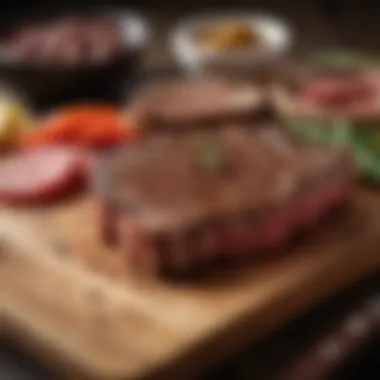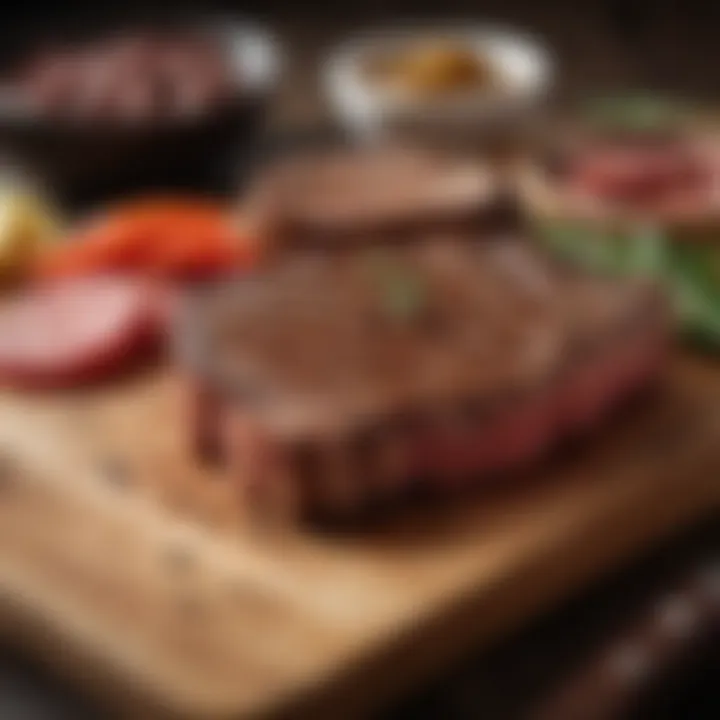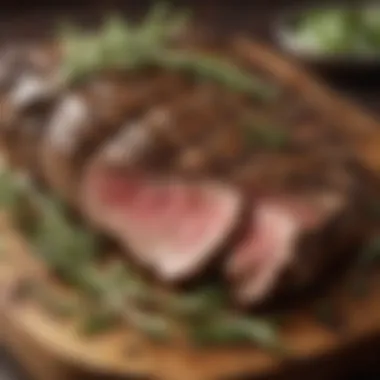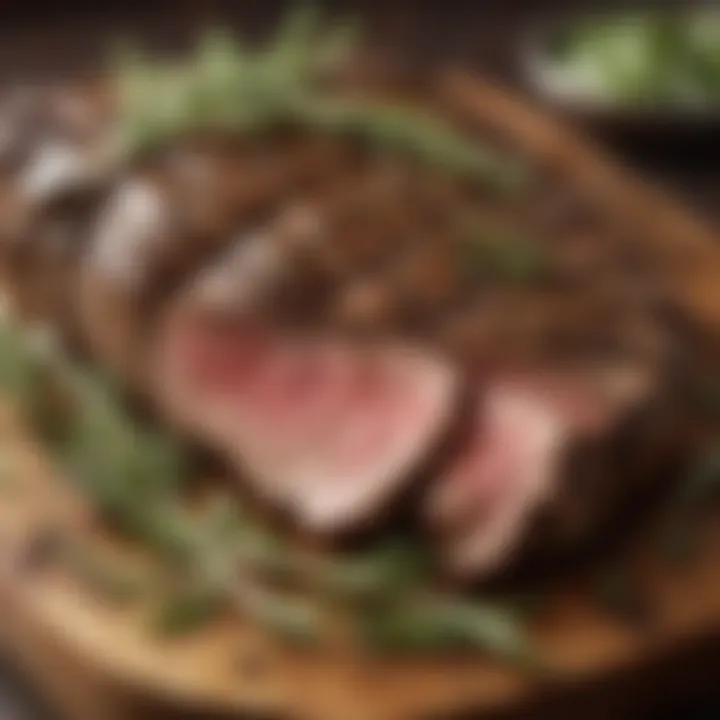Discovering Budget-Friendly Steak Cuts for Savvy Cooks


Intro
In recent years, culinary professionals and home cooks alike have embarked on a quest for value in the kitchen. In a world where premium cuts of beef can break the bank, discovering quality yet inexpensive steak options can transform weeknight dinners from mundane to memorable without draining your wallet. Understanding the various cuts of beef and how they can be prepared is vital in making informed choices that not only please the palate but also fit within budget constraints.
Many folks tend to gravitate towards familiar cuts such as ribeye or filet mignon, assuming these are the gold standards. However, lesser-known cuts might surprisingly offer exceptional flavors, tenderness, and versatility at a fraction of the price. This exploration into the lesser-known but equally delicious cuts of beef is an invitation to rediscover meal preparation in a resourceful and rewarding way.
With a focus on achievable cooking methods, including grilling, braising, and slow-cooking, this concise guide aims to elevate the practicality of beef preparation. Understanding muscle fiber, marbling, and cooking technique can make all the difference in achieving that mouthwatering steak experience.
Before diving into specific cuts, let’s take a smoother approach — gather around the table and learn how to turn a budget-friendly cut into a sensational dish that doesn’t compromise on taste.
Stay tuned as we explore recipes, techniques, and tips that showcase the best of what economical steak options have to offer.
Understanding Steak Cuts
Steak is not just a meal; it’s an experience that can range from humble to extravagant based on the cuts chosen. When discussing affordable steak options, understanding steak cuts is paramount. Each cut has its own narrative, with characters that influence flavor, tenderness, and cooking methods. An effective grasp of these cuts helps in selecting the right one to save money while delivering a delightful meal.
Choosing the right cut can significantly impact your cooking and dining experience. Recognizing that some steak cuts can emerge as pocket-friendly options without sacrificing flavor opens doors to exploration in culinary practices. Affordable steak cuts encourage creativity in meal preparation, allowing the budget-conscious home cook to maintain gourmet aspirations without an extravagant spend.
The Anatomy of a Steak
When you break it down, steak is like a jigsaw puzzle made from various beef muscles that each contribute to the whole. The key muscles include the longissimus dorsi, the psoas major, and more, each representing distinct cuts with unique attributes.
The longissimus dorsi, for example, is the primary muscle used for the ribeye or strip steaks, known for their marbling and flavor. Alternatively, the filet mignon comes from the psoas major, which is leaner but melts in your mouth. Understanding how each part works helps in picking the best cuts for your budget without neglecting quality.
Each section of a cow offers different textures and flavors; knowing these can really change how a cut cooks up. Some might translate better in fancier preparations, while others shine in simplicity.
Factors that Determine Steak Quality
Several crucial factors influence steak quality, impacting both taste and texture.
- Marbling: This refers to the visible fat interspersed within the muscle. High marbling generally indicates a flavorful cut. Look for specks of fat that will render down during cooking.
- Age of the Meat: Aging beef can significantly enhance its flavor profile. Dry-aging enhances depth of flavor while tenderizing the meat. It may cost more, but the payoff is fantastic for special occasions.
- Grass-Fed vs. Grain-Fed: The diet of the cattle can heavily influence the taste and health aspects of the steak. Grass-fed beef tends to be leaner with a different flavor.
- Grass vs. Grain: Always a discussion topic! Grass-fed cows produce meat that is leaner and has a distinct taste that sometimes isn’t for everyone. Grain-fed offers more marbling and a familiar taste but can lead to higher cholesterol.
- Cooking Technique: Lastly, how a steak is cooked can change its perception of quality. An affordable cut, if cooked well (like with marinating or slow cooking), can taste just as delightful as a pricier cut.
Reflecting on these factors allows the savvy home cook to make informed decisions when selecting meat, ensuring that even budget-friendly cuts of steak can deliver satisfaction without overspending.
Defining Cheap Steak Cuts
When it comes to satisfying appetites while keeping a firm grip on your wallet, understanding cheap steak cuts becomes crucial. Not only do these cuts provide nourishment, but they also hold the potential for flavor-packed meals without draining your finances. Knowing how to define these cuts involves not just knowing the names but also grasping their culinary possibilities and the ways to enhance their appeal.
Understanding the Price Range
Cheap steak cuts span a diverse price spectrum that often leaves many scratching their heads. Pricing is impacted by several factors, including the animal’s age, the cut’s rarity, and where it lies on the animal. For example, while a ribeye or filet mignon comes with a price tag that could give anyone a second thought, cuts like flank and skirt steak are not only less expensive but also cut from well-used muscles, making them flavorful when cooked correctly.
In the world of budgeting, knowing what to expect from different pricing tiers can be invaluable. Generally, steak cuts priced below $8 per pound could be categorized as cheap, whereas anything above that sinks into premium territory. Having clarity on these ranges can help steer decisions on what to place in the cart while shopping.
"The best steak isn’t always the most expensive one. Find value in unexpected places.”
Furthermore, it’s noteworthy that local markets or butchers might operate under different pricing structures. Being savvy about where you source your meat can impact both quality and cost. For instance, farmers' markets often have reasonably priced cuts that are just as fresh as higher-priced alternatives.
Value vs. Cost in Meat Selection
Choosing cheap steak cuts doesn’t automatically equate to settling for less. In fact, understanding the distinction between value and cost is essential in meat selection. While cost reflects monetary outlay, value digs deeper, examining the goods’ benefits relative to the price.
When navigating cheap steak options, consider what you’re getting for your money. Inexpensive cuts may need a little extra TLC through seasoning, marinating, or specialized cooking techniques to truly shine, but the outcomes can be mouthwatering. For instance, a well-marinated skirt steak served in tacos might leave any costly cut in the dust when it comes to flavor.
On the other hand, splurging on premium cuts could tempt some, but what happens if it goes to waste? If a high-priced cut becomes overcooked or improperly seasoned, the investment goes down the drain. Therefore, to maximize the benefits of meat selection, it’s about wrestling with the cost you’re willing to pay and the value you aim to extract from that cut.
Popular Inexpensive Steak Cuts
When it comes to enjoying a good steak without breaking the bank, knowing your options is crucial. Cheaper cuts of beef can provide just as much flavor and satisfaction as their pricier counterparts. This is especially relevant when trying to stretch a dollar in today’s economy. The popularity of inexpensive steak cuts lies in their unique characteristics and versatility in the kitchen. By exploring these cuts, readers can elevate their culinary repertoire while maintaining a respectable budget.
Flank Steak: Characteristics and Uses
Flank steak is recognized for its intense beefy flavor. It’s taken from the lower chest or abdominal muscles of the cow and has a long grain, making it a bit tougher than other cuts. However, its rich taste makes it well worth the effort. The key with flank steak is to slice it against the grain, which helps to maximize tenderness.


Typically used in dishes like fajitas, flank steak can also shine in a marinated grilled preparation. A simple marinade with soy sauce, garlic, and lime juice can work wonders, infusing layers of flavor while helping to tenderize the meat.
Skirt Steak: Cooking Techniques
Skirt steak is another budget-friendly option, known for its smoky flavor and fibrous texture. It’s more tender than flank steak but benefits from quick cooking methods. Skirt steak responds well to high heat, making it ideal for grilling and pan-searing.
One effective technique is to cook it hot and fast—sear on high heat for just a few minutes on each side. To enhance its taste, some cooks recommend using a dry rub or a marinade to add complexity. After cooking, let it rest for a few minutes before slicing. This cut also shines in stir-fries or as the filling in tacos due to its strong flavor.
Chuck Eye Steak: A Hidden Gem
Often overlooked, chuck eye steak offers a tender texture at a fraction of the price of ribeye. Situated just next to the ribeye on the cow, this cut retains a great flavor. It is ample in marbling, helping it stay juicy when cooking. While it can be grilled, it’s also fantastic for braising.
Slow-cooking a chuck eye can bring out incredible flavors, particularly when combined with root vegetables and herbs. It’s budget-friendly with a taste that sings, often surprising those who opt for it over more popular cuts. A hearty pot roast utilizing chuck eye can delight any dinner guest.
Brisket: More than Just Barbecue
Brisket is synonymous with flavorful barbecue, but its potential goes beyond just the grill. While it usually takes longer to cook due to its toughness, when prepared properly, it offers exquisite flavor and tenderness. The secret to a great brisket is low and slow—cooking it at a low temperature allows the connective tissues to break down over several hours.
This cut can be celebrated not only in barbecue but also in hearty soups and stews, absorbing rich flavors from the broth. Think about making classic dishes like smoked brisket or braised brisket with gravy on a cold evening.
Sirloin: Versatility Explained
Sirloin isn’t just another cut. It’s a versatile piece of meat, falling between the more expensive cuts and the budget-friendly ones. It’s lean yet flavorful, making it adaptable for various cooking methods, whether that be grilling, broiling, or stir-frying.
The top sirloin is often considered a step up, delivering a richer taste while remaining economical. It can be marinated and grilled like a steak or used in a stir-fry dish for a quick weeknight meal. With a little creativity, sirloin can star in a gourmet dinner without the premium price.
Cheap or not, each of these cuts invites culinary exploration, turning what might seem like ordinary dinners into memorable experiences.
Cooking Techniques for Cheaper Cuts
When it comes to crafting a delightful steak meal on a budget, the cooking methods you employ can make all the difference. This section zeroes in on how particular techniques can elevate the often-overlooked inexpensive cuts, bringing out their unique flavors even when wallets are tight. From marinating to cooking methods, understanding how to properly prepare these cuts not only enhances taste but also contributes to a more enjoyable dining experience.
Marinating for Enhanced Flavor
A good marinade can turn an ordinary piece of lesser-known beef into something extraordinary. When you think about what marinating does, it’s like giving the meat a flavor bath that can tenderize and infuse it with delicious seasonings. The beauty of marinating is that it opens up a whole new world of tastes for cheaper steak cuts, such as flank or chuck eye.
Typically, a simple marinade consists of acid (like vinegar or citrus juice), oil, and herbs or spices. For example, using a mixture of soy sauce, olive oil, garlic, and a dash of honey can brighten up the rich flavors inherent in cuts like brisket. Letting the meat sit in the marinade for at least an hour—or even overnight—can noticeably enhance the eating experience.
Besides flavor enhancement, marinating can help in tenderizing the meat. The acidity breaks down proteins, making even the toughest cuts more palatable. As a simple rule of thumb: the tougher the cut, the longer you should let it marinate.
Grilling vs. Pan-Seering: Which is Better?
Here lies a classic debate among steak enthusiasts: is grilling or pan-searing the superior cooking method for budget cuts? In reality, the answer often comes down to personal preference and the specific cut in question.
Grilling offers a smoky flavor and the ability to cook larger cuts at once, making it ideal for summer barbecues. It’s especially effective for cuts like skirt steak, which benefit from quick cooking at high heat. The result? A beautifully charred exterior with juicy meat that can be sliced thin for fajitas or served alongside fresh salsa.
However, pan-searing triumphs when it comes to flexibility, especially for those who live in apartments or areas without outdoor grills. A well-seasoned cast-iron skillet can produce a nice crust on flank or chuck eye steaks. Additionally, basting with butter and garlic during the cooking process adds depth to the flavor, sealing in moisture and yielding a mouthwatering dish.
Each method has its merits, proving that a tight budget doesn’t mean compromising on cooking quality.
"Cooking techniques can not only make budget cuts tender but also unlock a treasure trove of flavors when done just right."
Slow Cooking for Tenderness
If you’ve got the time, slow cooking is your best friend. The method works wonders for unfamiliar cuts that often require more time to break down tougher fibers, such as brisket or chuck steak. Utilizing a slow cooker can make the cooking process hands-off and remarkably simple.
By cooking low and slow, you allow the collagen in the meat to melt, transforming your cut into a tender delight that practically falls apart. Add in vegetables, broth, and your favorite spices, and leave it to bubble away all day. This method not only yields a flavorful meal but also stretches your budget even further, as it often produces leftovers that can be reheated with little fuss.
Nutritional Aspects of Cheaper Cuts
When considering cuts of steak often deemed affordable, it’s crucial to not overlook their nutritional profile. Many believe that cheaper cuts lack in quality, not realizing that these meats can contribute significantly to a balanced diet. In this section, we will delve into the nutritional benefits of these cuts, focusing on protein content, health advantages, and differences in fat composition.
Protein Content and Health Benefits


Steak, regardless of whether it's a high-end filet mignon or an affordable flank, is primarily lauded for its protein content. This macronutrient plays a vital role in our diets as it helps with muscle repair, immune function, and the creation of enzymes and hormones. Cheaper cuts like chuck eye and brisket still pack a hefty protein punch, often containing about 25 to 30 grams of protein per 3-ounce serving.
Moreover, incorporating these cuts into a diet can yield significant health benefits. For instance, the iron found in red meat is essential for producing hemoglobin, which carries oxygen in the blood. Deficiency in iron can lead to anemia, making it even more important to consider these nutritious cuts. Despite some misconceptions about lower quality, the protein sourced from these cuts can support active lifestyles and health goals without breaking the bank.
To maximize the health benefits, consider methods of preparation that preserve nutritional integrity, like grilling or slow cooking.
Remember: Eating well on a budget doesn’t mean sacrificing nutrition. Affordable steak cuts can be a smart choice for those looking to maintain a healthy diet while being mindful of spending.
Fat Content: Understanding Lean vs. Fatty Cuts
When we talk about the nutritional aspects of beef, we can’t ignore the significance of fat content. Understanding the differences between lean and fatty cuts can help one make informed decisions that align with their dietary needs. Lean cuts, such as sirloin and flank steak, have a lower fat percentage, typically around 10 grams per serving. In contrast, you might find cuts like rib-eye or chuck roast carrying upwards of 20 grams of fat.
However, not all fat is bad. Some fats, particularly monounsaturated fats, can be beneficial, helping to improve cholesterol levels and providing energy. The key is moderation and balance.
- Lean Cuts: Tend to be chewy and flavorful, great for grilling and quick cooking.
- Fatty Cuts: Offer richer flavor profiles, suited for slow cooking and braising to enhance tenderness.
Being aware and understanding fat content allows individuals to tailor their meals according to personal health goals. It’s all about finding that sweet spot where flavor meets nutrition. So, the next time you’re picking out a steak, consider what cut aligns with your health and culinary aspirations.
Seasoning and Sauces for Budget Cuts
When it comes to budget cuts of steak, one might think that flavor takes a backseat to cost. However, seasoning and sauces have the potential to completely transform an economical cut into something that feels gourmet. This segment emphasizes the vital role that seasoning and sauces play, not only in enhancing flavors but also in elevating the dining experience without breaking the bank.
Enhancing Flavor with Simple Ingredients
Flavor enhancement doesn’t always mean you need a pantry full of exotic spices or gourmet ingredients. Often, it's the basics that can shine in the simplest ways. Consider the age-old combination of salt and pepper. These two staples, when used correctly, can enhance the natural flavors of any cut of meat. Just as the stars shine brighter alone in the night sky, sometimes simple is best.
Another approach involves the use of fresh herbs. Items like rosemary, thyme, and parsley can work wonders. A sprinkle of minced fresh herbs before serving not only gives a pop of color but adds layers of flavor that are often more pronounced on budget cuts. Furthermore, garlic can dramatically change the taste profile. Whether minced, roasted, or used as a powder, garlic adds depth and richness that makes an affordable steak taste expensive.
Incorporating acids, like lemon juice or vinegar, can also brighten up the meat. A light squeeze after cooking can cut through any potential fattiness while enhancing succulent flavors. Moreover, a mixture of olive oil and vinegar can serve as a simple marinade, making the steak tastier and more tender.
"Sometimes the secret to a great meal lies in the simplest ingredients."
Homemade Sauces for Cost-Effective Cooking
No discussion about steak seasoning would be complete without homemade sauces that can elevate even the least expensive cuts to a realm of culinary delight. Store-bought sauces often come with a hefty price tag and additives that might not be desirable. Crafting your own sauces offers both economical and health-conscious solutions.
Chimichurri, a bright and zesty sauce, is an excellent starting point. Made primarily from parsley, garlic, vinegar, olive oil, and seasonings, it marries well with flavors of various cuts, making it a perfect companion for grilled steak.
Another fabulous option is a red wine reduction. This sauce exudes elegance and sophistication. Simply simmer red wine with a bit of shallot and a sprig of thyme until it thickens, adding a rich, luxurious texture to your steak. Not only does this bring out the steak's natural flavors, but it also provides an air of refinement.
A traditional barbecue sauce can easily be made from ketchup, vinegar, and brown sugar, with optional spices to taste. This blend serves as excellent glazing or dipping sauce for a smoky finish. Here’s a basic recipe to try:
Creating sauces not only enhances flavor but also allows cooks to use regional flavors or personal preferences to make the meal unique. The art of seasoning and sauce-making can ultimately turn any budget cut into a memorable meal, proving that one doesn’t need to spend a fortune to enjoy great steak.
Moreover, exploring these homemade options encourages creativity and resourcefulness in the kitchen, inviting more adventurous cooking that transforms everyday meals into something special.
Creating Balanced Meals with Affordable Cuts
In today's world, being mindful of our budgets isn’t just a trend; it’s a necessity. When it comes to steak, premium cuts can hit the wallet pretty hard. However, crafting balanced meals with affordable cuts is a resourceful approach that allows food lovers to enjoy hearty and wholesome dishes. This section underscores the relevance of pairing those budget-friendly steaks with the right accompaniments for a well-rounded meal experience. Shifting focus from just affordability to nutritional balance can elevate your cooking game significantly.
Pairing Steak with Vegetables and Sides
Pairing steak with the right vegetables and sides can turn a simple, economical cut into a sensational dinner. The robust nature of various steak cuts complements a wide range of vegetables, bringing out their flavors while adding nutritional value. For instance:
- Roasted Root Vegetables: These are not only easy to prepare but also enhance the sweetness in your meal, offering a delightful contrast to the savory steak.
- Seasonal Greens: Think of sautéed kale or steamed broccoli. They are loaded with vitamins and provide a fresh texture.
- Starches: Mashed potatoes or quinoa can serve as a filling side. They soak up juices and seasonings from the steak.
When you layer flavors thoughtfully, the steak becomes the star player, while the sides flesh out the dish. You take an inexpensive flank steak, grill it to perfection, and serve it alongside garlic butter asparagus and creamy mashed potatoes—suddenly, yum doesn’t seem so far-fetched!
Incorporating Grains for a Complete Dish


Incorporating grains into your steak meal not only brings a hearty feel but also rounds out the dish with essential nutrients. Whole grains like brown rice, quinoa, or barley add fiber and create a satisfying foundation beneath your protein.
Consider this a strategy for a full-fledged plate:
- Base of Grains: Start with a bed of fluffy brown rice or seasoned quinoa. Each grain brings its unique texture and flavor, enhancing the meal.
- Top with Steak: After cooking your affordable steak cut—say a cut from the shoulder—slice it thin and lay it over the grains.
- Add Veggies: Toss some colorful roasted peppers or a sprinkle of greens on top for vibrancy and nutrition.
"A well-prepared dish is a symphony of flavors, where each ingredient plays its part harmoniously."
Combining grains with affordable steak cuts creates a fulfilling meal. Not only does this method utilize less expensive meat options, but it also respects the body's need for variety and balance. With a bit of planning and creativity, cooking on a budget can become an exciting culinary adventure.
Real-Life Applications and Meal Ideas
When it comes to budget-friendly cooking, understanding how to incorporate affordable steak cuts into everyday meals can be a game changer. The significance of real-life applications lies not only in putting meals on the table but also in enhancing culinary creativity while keeping expenses in check. Cheaper cuts don’t mean sacrificing flavor; rather, they present a canvas for culinary exploration that meets both financial and gastronomic desires.
By knowing the applications of these cuts, home cooks can prepare meals that are not only satisfying but also impressive. Using the right steak in a meal can elevate even the simplest dishes. Let’s dive into some practical ideas that can help you harness the flavors of affordable cuts without breaking the bank.
Quick Weeknight Dinners
For quick weeknight dinners, time is often of the essence but that doesn’t mean one has to compromise on taste. Cuts like skirt steak and flank steak are ideal for quick meals. A simple marinade of soy sauce, garlic, and ginger can transform these cuts into a delicious stir-fry. Just slice the steak thin and toss it in a hot skillet with fresh vegetables; you'll have a hearty dish in about 20 minutes.
Another option might be a classic beef fajitas, where sliced steak is cooked swiftly on high heat with bell peppers and onions. Throw it all together in a tortilla and serve with salsa, and dinner is sorted.
"The key to weeknight dinners is speed combined with simplicity. Use flavorful cuts you can grill or sauté quickly, and your meal will shine without all the fuss."
Meal Prep Solutions for Busy Families
Meal prepping can seem overwhelming, but it's a smart way to utilize cheaper cuts effectively. Cuts like chuck eye steak, when slow-cooked, can provide meals for several days. By preparing a large batch of beef stew, you can have sufficient portions set aside for those busy days ahead.
Tips for effective meal prep:
- Choose versatile cuts that can be used in multiple recipes.
- Cook larger quantities and divide them into portions.
- Mix cooked steak with vegetables or grains to create balanced meals.
Using flank steak for a salad or shredded beef tacos keeps flavors diverse throughout the week. This not only saves time but also ensures the family enjoys varied meals without laboring over the stove daily.
Impressive Weekend Feasts on a Budget
When the weekend rolls around, you may want to impress friends or family without stretching the budget. Cuts like brisket, often revered for their rich flavor, can be slow-braised to perfection. A smoky barbecue brisket served with homemade coleslaw can easily become the centerpiece of a gathering.
For a robust flavor experience, consider marinating chuck roast overnight and then roasting it on a Sunday afternoon. The process fills your home with delicious aromas and provides a tender, succulent meal perfect for family gatherings.
Ideas for weekend feasts:
- Create a steak night with tacos or sliders.
- Hold a barbecue with marinated chuck eye steaks, complemented by grilled veggies.
- Prepare a pot roast with root vegetables for cozy comfort food.
Using affordable cuts creatively can allow for feasts that are tasteful and memorable, proving that culinary talent can thrive on a budget.
Final Thoughts
As we wrap up our exploration of affordable steak options, it's essential to underscore the importance of understanding the value behind cheap cuts of beef. In a world where culinary preferences often lean towards the more expensive and trendy flavors, recognizing the quality and versatility of these underrated cuts offers not just a financial benefit but also a chance to enrich our culinary experiences.
Redefining Value in Meat Choices
When we talk about re-evaluating value in the realm of meat, we shift the focus from merely the price tag to a broader scope encompassing quality, flavor, and nutritional benefits. Cheaper cuts of beef, such as flank steak or chuck eye steak, often come with a bad reputation that doesn't align with their actual potential. Instead of gravitating towards well-known, pricier steaks, it's wise to explore these overlooked cuts.
Embracing these options can open a world of robust flavors and textures without putting a strain on the wallet. Here are some elements to consider when redefining value in meat selection:
- Flavor: Many inexpensive cuts are rich in flavor and, with the right technique, can be just as satisfying as more expensive options.
- Versatility: Cheaper cuts lend themselves to various cooking styles, from grilling to slow cooking, providing options for different culinary approaches.
- Health Factors: Often, budget cuts may be leaner, offering a nutritious choice at a lower cost.
- Sustainability: Choosing less popular cuts can also provide a more sustainable option, encouraging the utilization of the whole animal.
Redefining value doesn't just improve your cooking game; it's a statement about being resourceful, creative, and mindful in what we choose to put on our plates.
Encouraging Culinary Exploration on a Budget
The journey of culinary exploration should not come with a hefty price tag. By encouraging creativity and experimentation with budget options, it’s possible to enjoy delicious meals that don’t break the bank. Cooking with cheaper cuts opens up numerous avenues for innovation in the kitchen. Here are some ways to foster culinary exploration:
- Experiment with Marinades: A good marinade can transform a tough cut into something meltingly tender. Trying out different flavor profiles, such as sweet and tangy or spicy and savory, can lead to delicious discoveries.
- Try New Recipes: Seek inspiration from cuisines that traditionally utilize cheaper cuts, such as Latin American or Asian dishes. Discovering new recipes can introduce excitement in meal prep while maximizing the budget.
- Involve Family and Friends: Make cooking a communal activity. Challenge your loved ones to create their own dishes using inexpensive cuts. This experience can enhance skills and encourage sharing of unique techniques.
"Cooking is about creating a harmonious blend of tastes, aromas, and textures. On a budget, creativity can shine brighter than gold."
Taking the plunge into budget cuts doesn’t equate to sacrificing quality or taste. Rather, it’s an invitation to expand your culinary horizons while fostering an appreciation for the intricacies of beef cuts. By emphasizing both resourcefulness and creativity in the kitchen, you'll find that even the most ordinary ingredients can lead to extraordinary meals.







